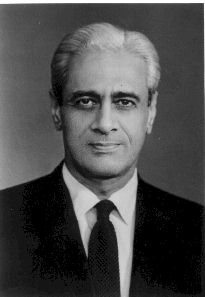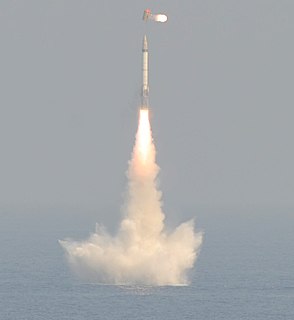Dr APJ Abdul Kalam Missile Complex [1] is a military missile research center in Hyderabad, India.
The complex has following three laboratories: [2]
Defence Minister, Manohar Parrikar on 15 October 2015 renamed DRDO Missile Complex at Hyderabad into Dr APJ Abdul Kalam Missile Complex. [3] [4] [5]

Avul Pakir Jainulabdeen Abdul Kalam was an Indian aerospace scientist who served as the 11th President of India from 2002 to 2007. He was born and raised in Rameswaram, Tamil Nadu and studied physics and aerospace engineering. He spent the next four decades as a scientist and science administrator, mainly at the Defence Research and Development Organisation (DRDO) and Indian Space Research Organisation (ISRO) and was intimately involved in India's civilian space programme and military missile development efforts. He thus came to be known as the Missile Man of India for his work on the development of ballistic missile and launch vehicle technology. He also played a pivotal organisational, technical, and political role in India's Pokhran-II nuclear tests in 1998, the first since the original nuclear test by India in 1974.

Satish Dhawan was an Indian mathematician and aerospace engineer, widely regarded as the father of experimental fluid dynamics research in India. Born in Srinagar, Dhawan was educated in India and further on in United States. Dhawan was one of the most eminent researchers in the field of turbulence and boundary layers, leading the successful and indigenous development of the Indian space programme. He succeeded M. G. K. Menon, as the third chairman of the Indian Space Research Organisation (ISRO) in 1972.

Dr. Abdul Kalam Island, formerly known as Wheeler Island, is an island off the coast of Odisha, India, approximately 150 kilometres (93 mi) east of the state capital Bhubaneswar. The Integrated Test Range missile testing facility is located on the island. The island was originally named after English commandant Lieutenant Hugh Wheeler. On 4 September 2015, the island was renamed to honour the late Indian president, Dr. APJ Abdul Kalam.

Kota Harinarayana is an aviation engineer popularly considered as the "Father of the Indigenous fighter programme in India". He was born in a Telugu speaking family in Brahmapur on the border of Odisha and Andhra Pradesh. He was appointed as Chairman of the Board of Governors of IIT (BHU), Varanasi by Hon'ble President of India on 25th August, 2020 for three years. He was the Vice-Chancellor of the University of Hyderabad and the President of the Aeronautical Society of India.
Lab Quarters, also DRDO Township and Kanchanbagh, is a colony in Old City, Hyderabad, Telangana, to accommodate the employees working in the Defence Laboratories of DRDO. It is well connected with the city, the Midhani depot being just adjacent to it. Lab Quarters is one of the largest colonies in Hyderabad, comparable to those of Bharat Heavy Electricals Limited and Kukatpally Housing Board.
The Indian Ballistic Missile Defence Program is an initiative to develop and deploy a multi-layered ballistic missile defence system to protect India from ballistic missile attacks.
A Sivathanu Pillai is an Indian scientist who formerly served as Honorary Distinguished Professor at Indian Space Research Organisation (2015-2018) and an honorary professor at IIT Delhi in the Department of Mechanical Engineering (2015-2016) and a Visiting Professor at Indian Institute of Science (2014-2015).

The HSTDV is an unmanned scramjet demonstration aircraft for hypersonic speed flight. It is being developed as a carrier vehicle for hypersonic and long-range cruise missiles, and will have multiple civilian applications including the launching of small satellites at low cost. The HSTDV program is being run by the Defence Research and Development Organisation (DRDO).

The K family of missiles, named after Indian scientist and former president A. P. J. Abdul Kalam, is a family of submarine-launched ballistic missiles (SLBM) developed by India to boost its second strike capabilities and thus augment its nuclear deterrence. Information about this family of missiles has mostly been kept classified. It is reported that "K" missiles are faster, lighter and stealthier than their Agni missile counterparts.
The use of rockets in India, for warfare, dates back to the 18th century. Mysorean rockets were the first iron-cased rockets that were successfully deployed for military use, reverse-engineered by British and introduced in the Europe as Congreve rocket. After British colonisation of India, scientific R&D in Indian dynasties was restricted and military science in India lagged.

Colathur Rama Krishnaswamy Rao SahibIAS, PV was an Indian civil servant who served as 15th Cabinet Secretary of India from 1981-1985. He also served as the Principal Secretary to Prime Minister Charan Singh. when Indira Gandhi became the Prime Minister of India. He was awarded the second highest civilian honor of India, Padma Vibhushan in 2006, besides the Great Maratha Award in 2009. His maternal grandfather was R. Ramachandra Rao, Collector of Nellore, who helped Srinivasa Ramanujan during latter's formative years.
Vallampadugai Srinivasa Raghavan Arunachalam is an Indian scientist. He is the founder and Chairman of CSTEP, a science and technology think tank.
Prahlada is an Indian missile scientist, former vice chancellor of Defence Institute of Advanced Technology and a former director of Defence Research and Development Laboratory, the largest of the Defence Research and Development Organization laboratories in India, known for his contributions to Indian space programme. He was honoured by the Government of India in 2015 with Padma Shri, the fourth highest Indian civilian award.
Ramadas Panemangalore Shenoy was an Indian defence scientist and writer, known for his contributions in the field of Radar technology. He secured a doctoral degree in Electrical Engineering from the University of Wisconsin–Madison and joined Defence Research and Development Organization in 1961, involving himself with the indigenous development of Radar technology till his retirement, as a Distinguished Scientist, in 1989.

Dr G Satheesh Reddy, Secretary, Department of Defence R&D and Chairman, Defence Research and Development Organisation (DRDO), spearheads indigenous development of defence systems and technologies. As the top defence scientist in the country, Dr Reddy guides the development of major programs on missiles and strategic systems, fighter aircraft and unmanned aerial defence systems, underwater systems, radar systems, strategic materials, armaments, and futuristic technologies. A visionary and institution builder, his technology leadership has deeply impacted the development of ‘best in class’ systems for the Indian Armed Forces.
Research Centre Imarat (RCI) is a DRDO laboratory located in Hyderabad, Telangana. The lab is responsible for Research and Development of Missile Systems, Guided Weapons and advanced Avionics for Indian Armed Forces. It was established by APJ Abdul Kalam in 1988. Scientist and avionics specialist BHVS Narayana Murthy is presently the Director RCI Laboratory.

Quick Reaction Surface-to-Air Missile (QRSAM) is a missile developed by the Defence Research and Development Organisation (DRDO), Bharat Electronics Limited and Bharat Dynamics Limited for the Indian Army, meant for protecting moving armoured columns from aerial attacks.

Arun Kumar Tiwari is an Indian missile scientist, author, and professor. He has written several books and co-authored 5 books with Dr. APJ Abdul Kalam, including Wings of Fire, the autobiography of Dr. APJ Abdul Kalam, former president of India. Published in 1999, Wings of Fire has become a modern classic with over 30 reprints selling over a million copies and was translated into 18 languages.
Sudhir Kumar Mishra is an Indian engineer, defence scientist and civil servant. He is currently a director general at the Defence Research & Development Organisation, and the chief executive officer and managing director of BrahMos Aerospace, a joint venture between India's and Russia's ministries of defence.